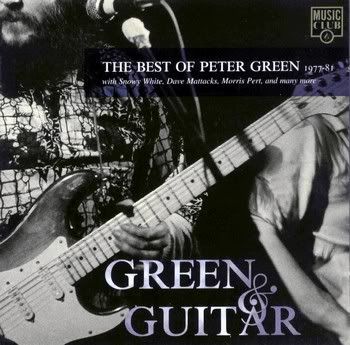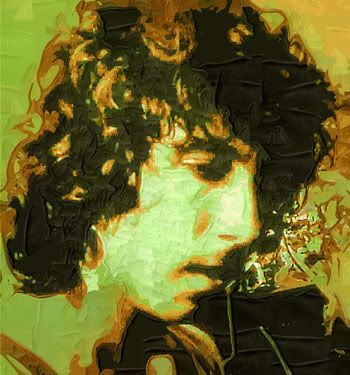
Peter Green - Green & Guitar: The Best Of Peter Green 1977- 81 - 1996 - Music Club International
Fleetwood Mac's original leader authored the classics "Black Magic Woman" and "The Green Manalishi," and ranked as one of Britain's greatest blues guitarists. Yet Peter Green's entrance into rock mythology had as much to do with the way he stepped away from music for many years (following a 1971 cultish religious conversion) as the way he arrived in 1967, fronting the early Mac on legendary tracks such as "Love That Burns" and "Albatross," and giving Eric Clapton a run for his money. In 1978, he returned to action, releasing the excellent In the Skies, as well as Little Dreamer, Whatcha Gonna Do, and White Sky, from which this well-considered and annotated retrospective is drawn. The elegance, edge, and astute phrasing of his guitar propels blues numbers "White Sky," "A Fool No More," and "Slabo Day," while his soulful, grainy, weary vocals on radio singles "Loser Two Times" and "The Clown" recall the Clapton of 461 Ocean Boulevard. © James Rotondi, © 2008 Amazon.com
Peter Green, the legendary British guitarist is regarded by many people as the greatest white blues guitarist ever. The great bluesman B.B. King once referred to Peter Green as "the only guitarist who ever made me sweat," and that's saying something from the blues legend. This particular "best of" compilation from the great bluesman a superb album, and stamped with "Greenie's" "deep blues" understated playing. The album by the "Black Magic Woman" man is HR by A.O.O.F.C. Buy his brilliant "Blues By Green" album, and listen to his exceptional "The Robert Johnson Songbook " and "Destiny Road" albums. Don't forget the classic Fleetwood Mac, "Then Play On" album with Peter Green at his best. There is info on Peter's great"A Fool No More" album @ PGREEN/AFNM and read the important comments on the track details by" LuckiLuc". Check out Fleetwood Mac's comprehensive "Madison Blues" album @ FMAC/MADBLUS and read about the great man's amazing musical pedigree @ PGREEN/BIO/WIKI
TRACK DETAILS
In The Skies - Date Performance: 1979 (Green, Green, Green)
Loser Two Times - Date Performance: 1979 (Green)
Cryin' Won't Bring You Back - Date Performance: 1979 (Green)
Last Train To San Antone - Date Performance: 1981 (Green)
Apostle - Date Performance: 1979 (Green,Green)
Little Dreamer - Date Performance: 1979 (Green,Green)
The Clown - Date Performance: 1981-05-00, Recorded at Ridge Studios, Surrey, England. (Green)
Got To See Her Tonight (Green,Green)
White Sky (Love That Evil Woman) - Date Performance: 1981-05-00, Recorded at Ridge Studios, Surrey, England. (Green)
Carry My Love - Date Performance: 1981-05-00, Recorded at Ridge Studios, Surrey, England. (Green,Green)
Slabo Day - Date Performance: 1979 (Bardens, Green, Green, Harada, Isidore, Langton, White)
A Fool No More - Date Performance: 1979 (Green,Green)
Baby When The Sun Goes Down - Date Performance: 1979 (Green)
Funky Jam - Date Performance: 1981-05-00, Recorded at Ridge Studios, Surrey, England. (Green,Green)
MUSICIANS
Peter Green (Guitar), (Vocals)
Snowy White (Guitar)
Pete Bardens (Keyboards),
Kuma Harada (Bass)
Reg Isadore (Drums)

SHORT BIO
His career riddled by drug abuse and paranoia, Peter Green is still regarded by some fans as the greatest white blues guitarist ever, Eric Clapton notwithstanding. As he grew up in London's working-class East End, Green's early musical influences were Hank B. Marvin of the Shadows, Muddy Waters, B.B. King, Freddie King, and traditional Jewish music. Born Peter Greenbaum but calling himself Peter Green by age 15, he played bass before being invited in 1966 by keyboardist Peter Bardens to play lead in the Peter B's, whose drummer was a lanky chap named Mick Fleetwood. The 19-year-old Green was with Bardens just three months before joining John Mayall's Bluesbreakers, whose rapidly shifting personnel included bassist John McVie and drummer Aynsley Dunbar. A keen fan of Clapton, Green badgered Mayall to give him a chance when the Bluesbreakers guitarist split for an indefinite vacation in Greece. Green sounded great and, as Mayall recalls, was not amused when Clapton returned after a handful of gigs, and Green was out. When Clapton left the band for good six months later to form Cream, Mayall cajoled Green back. Fans were openly hostile because Green was not God, although they appreciated Clapton's replacement in time. Producer Mike Vernon was aghast when the Bluesbreakers showed up without Clapton to record the album A Hard Road in late 1966, but was won over by Green's playing. On many tracks you'd be hard-pressed to tell it wasn't Clapton playing. With an eerie Green instrumental called "The Supernatural," he demonstrated the beginning of his trademark fluid, haunting style so reminiscent of B.B. King. When Green left Mayall in 1967, he took McVie and Fleetwood to found Peter Green's Fleetwood Mac. Jeremy Spencer and Danny Kirwan shortly afterward gave Fleetwood Mac an unusual three-guitar front line. Green was at his peak for the albums Mr. Wonderful, English Rose, Then Play On, and a live Boston Tea Party recording. His instrumental "Albatross" was the band's first British number one single and "Black Magic Woman" was later a huge hit for Carlos Santana. But Green had been experimenting with acid and his behavior became increasingly irrational, especially after he disappeared for three days of rampant drug use in Munich. He became very religious, appearing on-stage wearing crucifixes and flowing robes. His bandmates resisted Green's suggestion to donate most of their money to charity, and he left in mid-1970 after writing a harrowing biographical tune called "The Green Manalishi." After a bitter, rambling solo album called The End of the Game, Green saddened fans when he hung up his guitar, except for helping the Mac complete a tour when Spencer suddenly joined the Children of God in Los Angeles and quit the band. Green's chaotic odyssey of almost a decade included rumors that he was a gravedigger, a bartender in Cornwall, a hospital orderly, and a member of an Israeli commune. When an accountant sent him an unwanted royalty check, Green confronted his tormentor with a gun, although it was unloaded. Green went to jail briefly before being transferred to an asylum. Green emerged in the late '70s and early '80s with albums In the Skies, Little Dreamer, White Sky, and Kolors, featuring at times Bardens, Robin Trower drummer Reg Isidore, and Fairport Convention drummer Dave Mattacks. He reprised the Then Play On Mac standard "Rattlesnake Shake" on Fleetwood's solo 1981 album, The Visitor. British author Martin Celmins wrote Green's biography in 1995. Psychologically troubled, on medication, and hardly playing the guitar for most of the '90s, the reclusive Green resumed sporadic recording in the second half of the decade. He surfaces unexpectedly from time to time, most prominently January 12, 1998, when Fleetwood Mac was inducted into the Rock & Roll Hall of Fame. In a rare, perfect moment, Green jammed with fellow inductee Santana on "Black Magic Woman." © Mark Allan, All Music Guide





3 comments:
LINK Pt 1
LINK Pt 2
Thanks for this share: great album by a great artist.
I had listened to some of the better known songs featuring P. Green from his Mayall & Fleetwood periods and had a very high opinion of his playing and composing, but this one (I'm right now listening to it for the first time) shows how great a blues guitar player he is. It's weird: at times is difficult not to think it's Clapton playing!
Thanks!!
Howzitgoin' wazorama. They call Clapton "Slowhand." In his own way, Peter Green has a slow handed, laid back, understated style. Both great axemen, and Greenie was the driving force of the early Fleetwood Mac. Beautiful guitar technique, and always enjoyable to listen to his no frills playing. Thanks for comment.TTU soon
Post a Comment